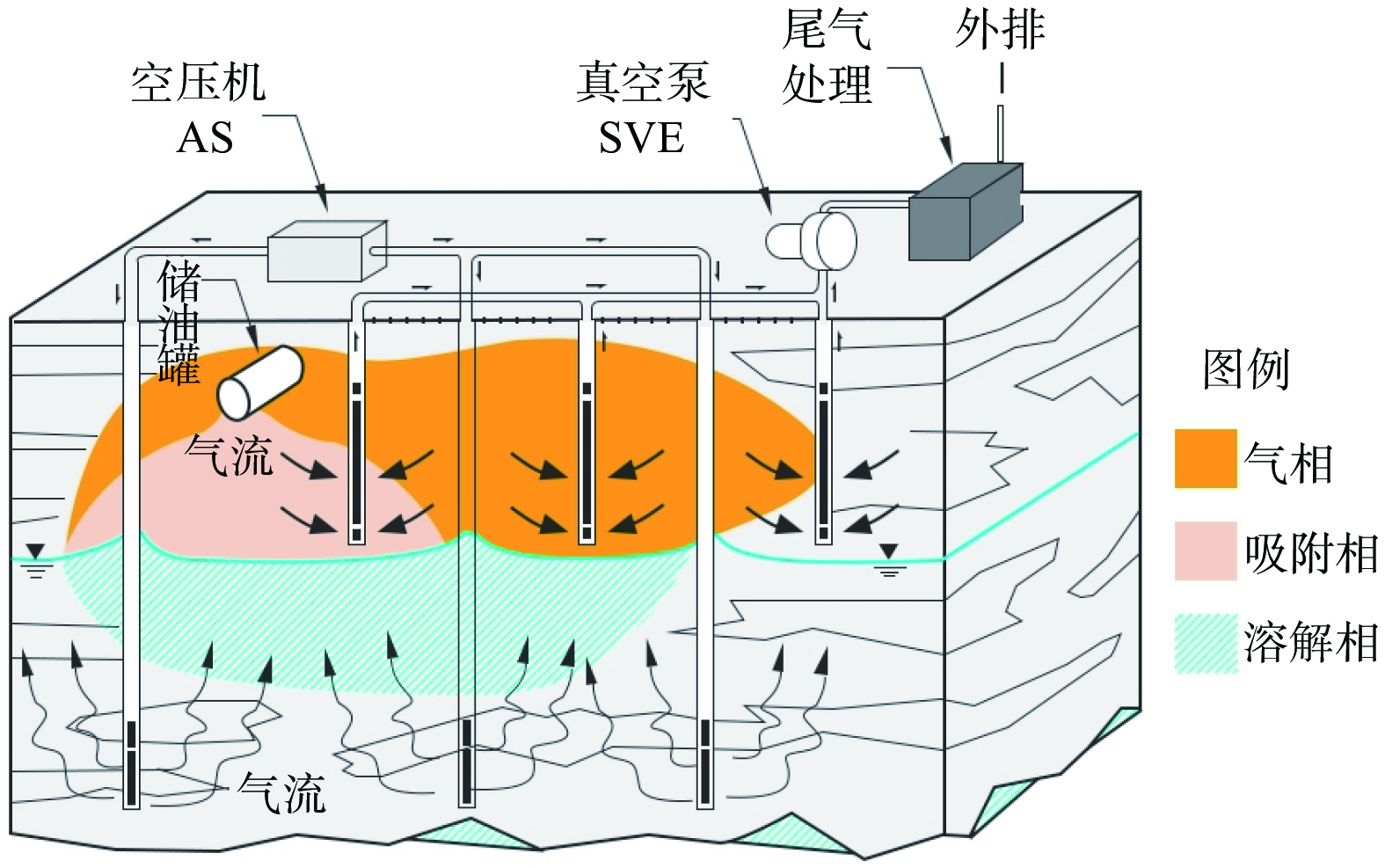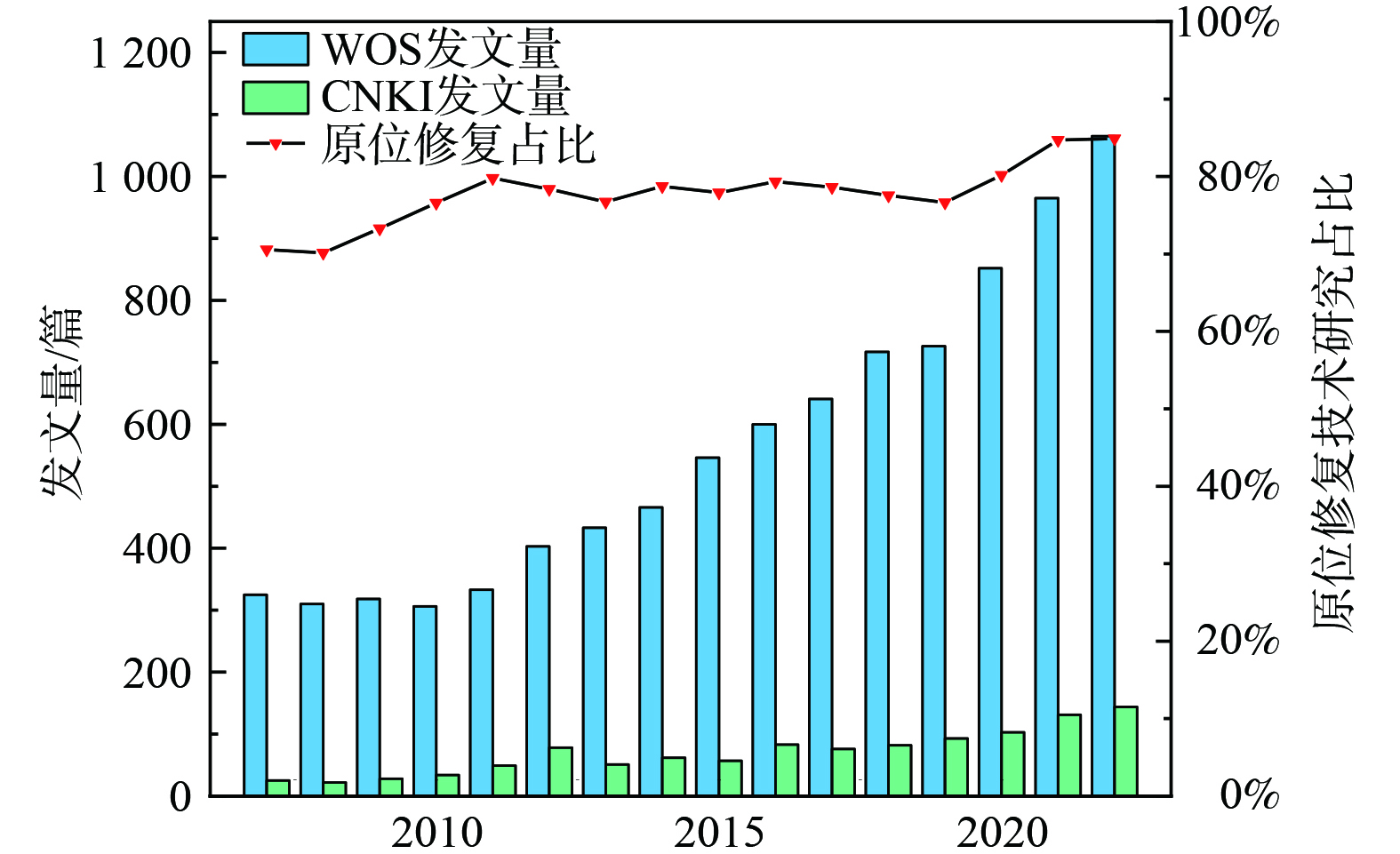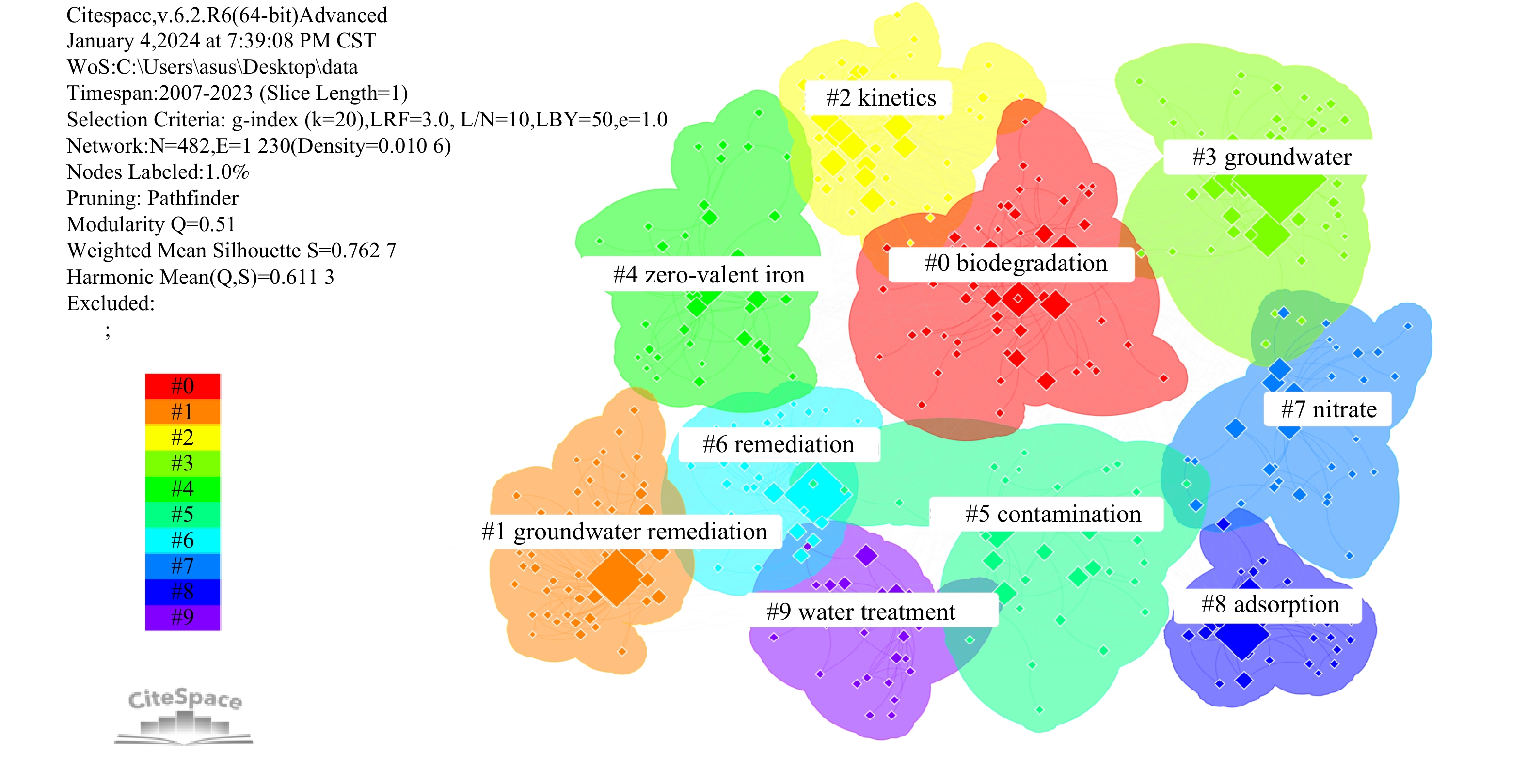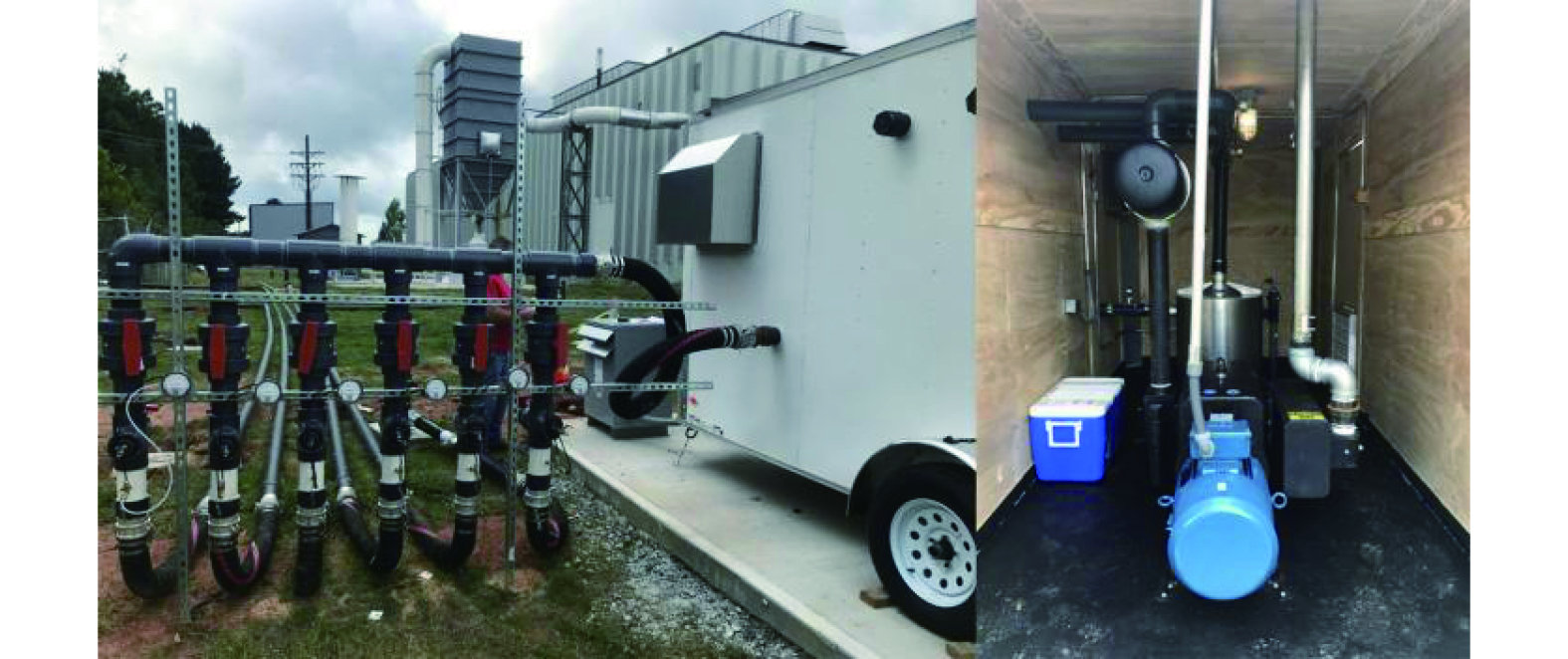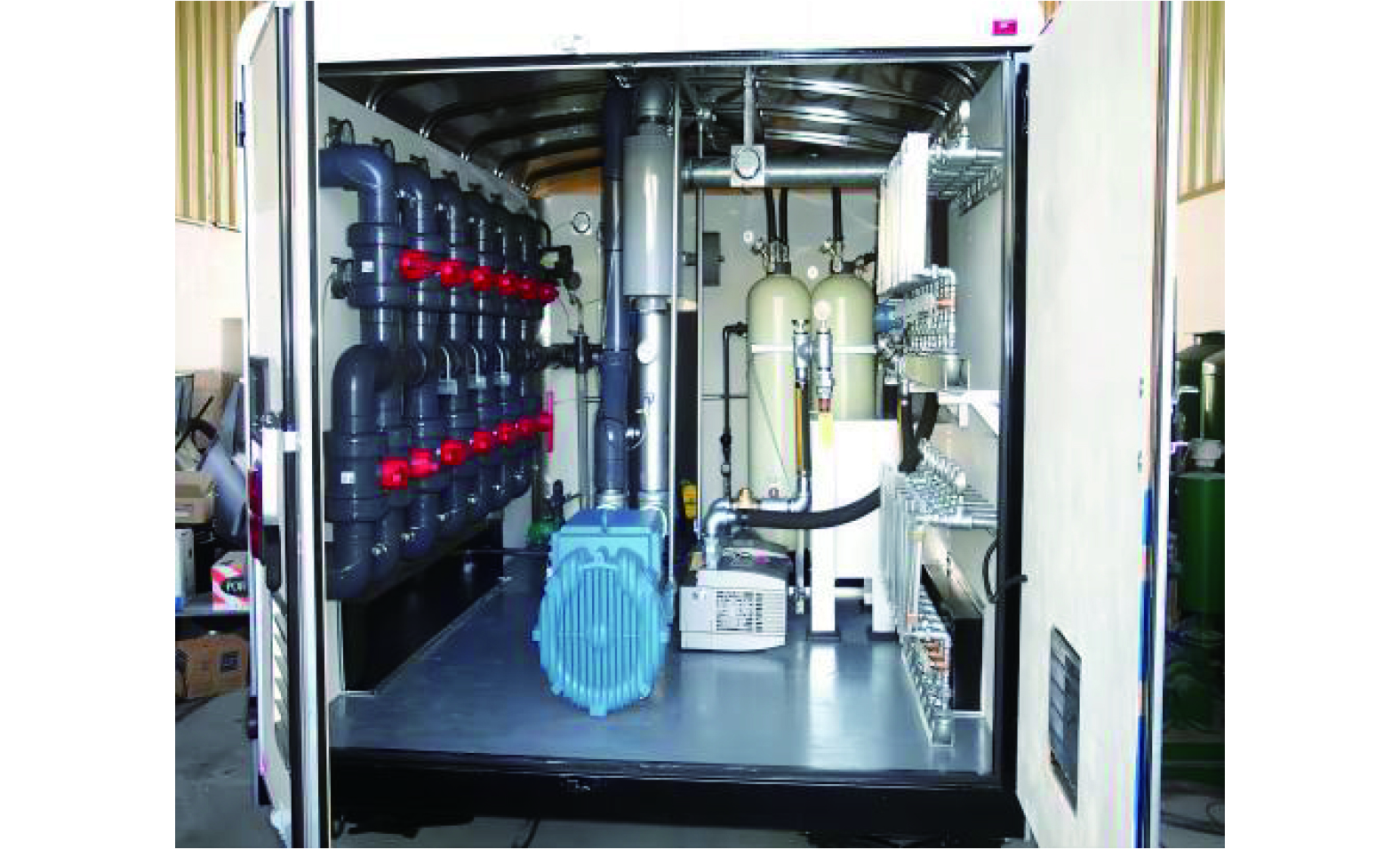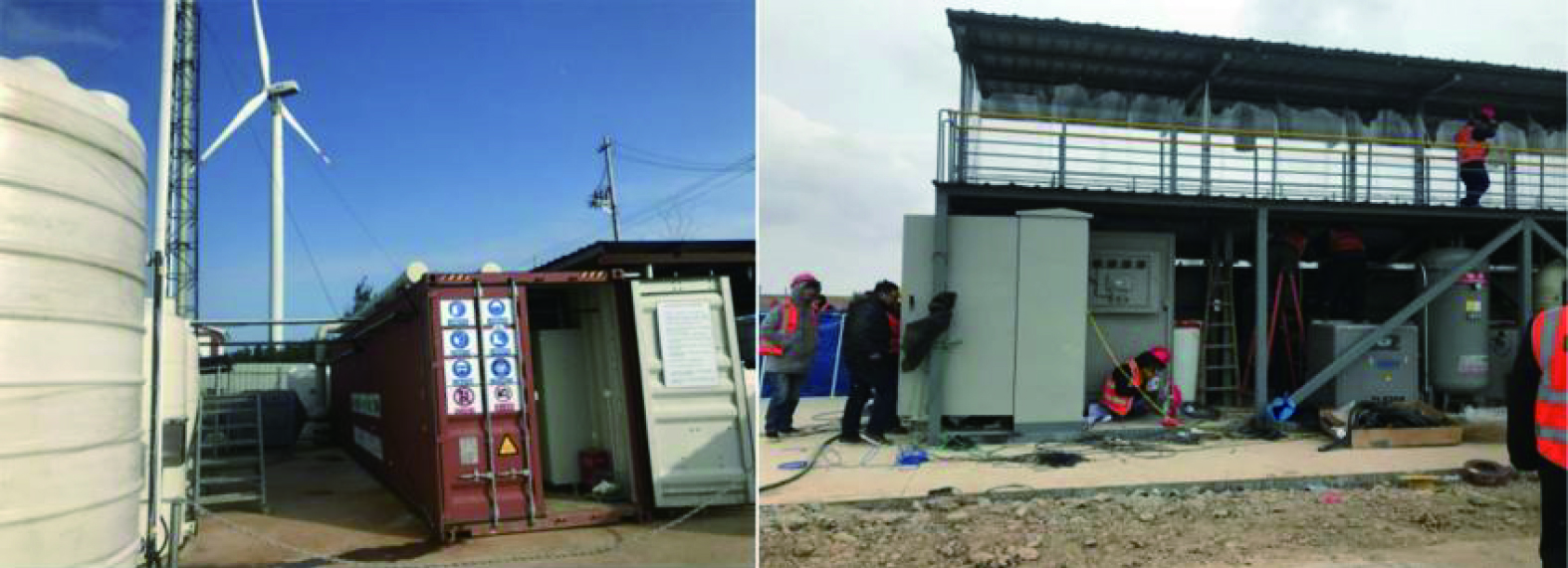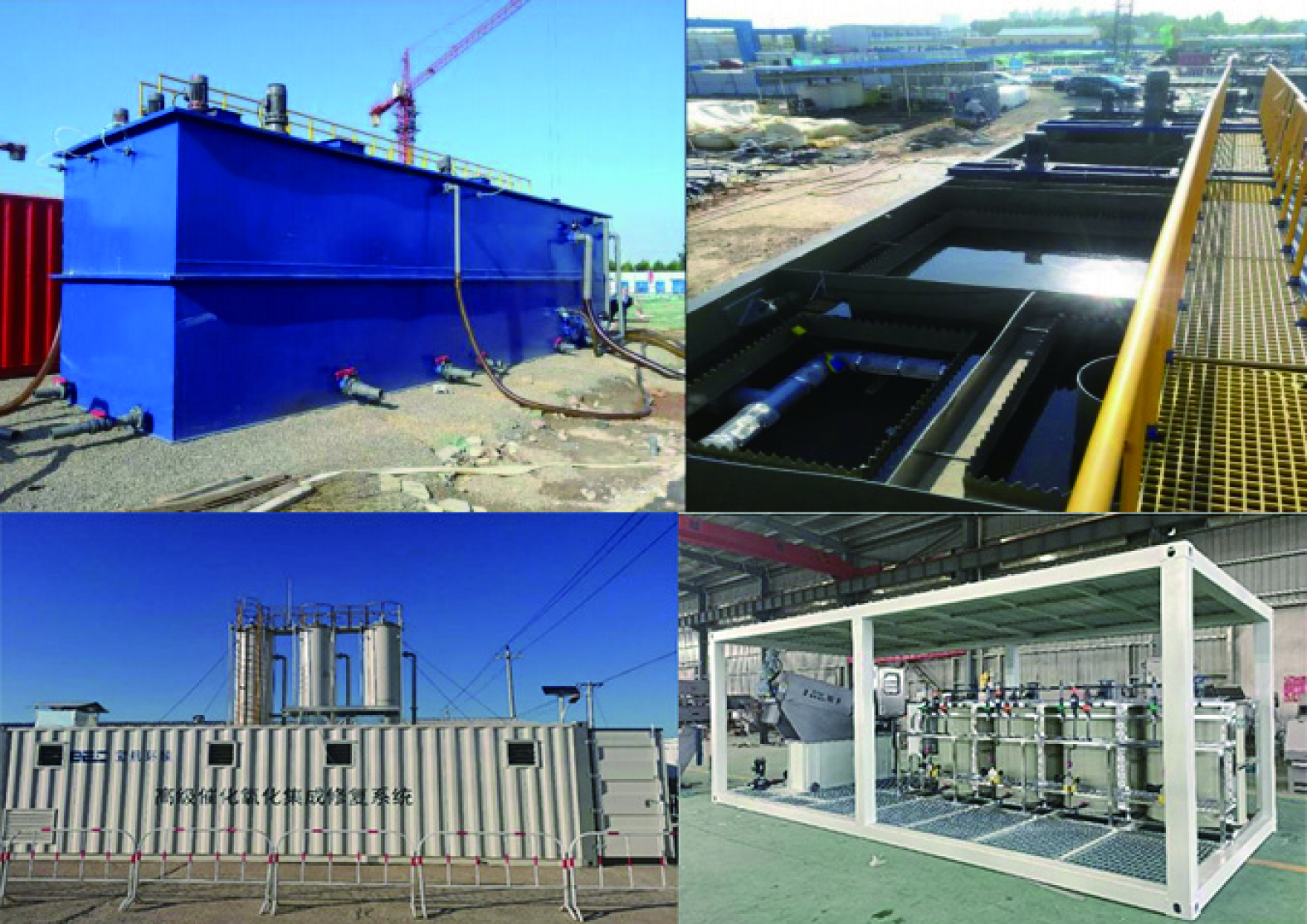-
随着工农业生产的迅速发展和社会人口的不断增长,各种施加在地表的污染物随下渗的水经过非饱和带进入地下水中,导致土壤和地下水污染问题加剧[1],在此背景下,高效的地下水污染修复技术和装备已经成为全球的普遍需求。目前,地下水污染修复领域已发展出多种原位及异位修复技术,诸如抽出-处理、曝气、多相抽提、化学修复、生物修复以及循环井技术[2-5]。这些技术在一些发达国家的实际应用中已取得显著成效。然而,由于水文地质条件的复杂性以及污染物的多样性[6-7],这些地下水污染修复技术在特定场地的应用中存在显著的不确定性,不同场地间的修复成效差异较大。
为了适应各类地下水污染情况和特定场地的水文地质条件,满足地下水污染修复技术的应用需求,大量先进的修复装备不断地被研发和优化[8]。例如,为了有效实施抽出-处理技术,研发了高效的抽水设备和精密的水处理系统[9-10];此外,针对化学修复技术,研发了化学试剂自动精准投加装备[11],以确保污染物能被有效降解或稳定化。
我国地下水修复技术及装备的研发仍处于起步阶段,与国际先进水平相比尚有较大差距。但随着国家对地下水污染场地问题的重视,加之政策倾斜,未来发展潜力巨大。分析地下水修复技术及装备产业环境存在的不足、探讨解决发展困局的措施显得尤为迫切。本文从地下水修复技术研究和地下水修复装备应用两方面进行阐述,归纳其研究现状及趋势并针对发展机遇及挑战进行了展望,以期为我国地下水污染修复行业的发展提供借鉴。
-
异位修复技术是通过收集系统或者抽提系统将污染地下水体转移到地面上,进行处理后使水体达到排放要求的技术。抽出-处理是目前全球最常用且研究最多的异位修复技术。其基本原理是将受污染的地下水通过泵提取至地面,进行进一步的净化处理,净化后的地下水可以重新注入含水层或排入地表水体,如图1所示。抽出-处理的设备与操作简单,成本较低,可以处理地下水中多种污染物 (如重金属、有机溶剂、新污染物等) [12-14],因此其应用范围较广,尤其在针对突发的污染事件时是最有效的修复手段。抽出-处理的优势在于污染物随着受污染的地下水被大量抽出,可以快速的降低污染物浓度[15]。同时,在抽出地下水的过程中,随着地下水水位的下降,会产生向井孔流动的水力梯度,形成降落漏斗,可以有效预防污染物的扩散[16-17]。
抽出-处理针对含水层中溶解性较好以及轻非水相液体 (LNAPL) 处理效果显著,但对于重非水相液体 (DNAPL) 的处理效果较差,并且对污染场地含水层介质的渗透性有一定要求 (大于10−5 cm·s−1) 。尽管抽出-处理在修复早期阶段有较好的效果,能高效去除污染物,但现有的研究及工程应用表明,其性能会随着时间的推移大幅下降[19]。近年来,学者们对这一现象的机制进行了广泛研究。目前,大多数学者认为在抽出过程中,流体优先从渗透性较高区域通过,而低渗透性区域受到的水力冲刷较小,导致污染物易赋存在这些区域[20]。抽出-处理后期,低渗透含水层介质中的污染物逐渐发生解吸和反向扩散现象,即拖尾和反弹[21-22]。此外,对地下水的大量抽取可能产生水资源的过度消耗[23]。以上这些因素是限制抽出-处理应用的主要原因。
虽然抽出-处理有其固有的劣势难以解决,但从另一方面而言,在针对如突发污染事件的应急处理等情况时,也具有一定不可替代的优势。因此在世界范围内仍有一定的应用。抽出处理需根据污染场地条件、修复效果合理布设井群,降低运行成本。近年来随着数值模拟技术的发展,关于抽出-处理的研究多集中于通过优化模型对抽出-处理实施方案进行模拟,如AKBARPOUR等[24]基于多种模拟模型优化了抽水井位置,确定了最佳的抽水方案。数值模拟需综合考虑多个影响因素和不确定性条件下的修复决策,任丽霞[25]基于地下水溶质迁移运输模拟结合多属性决策方法探究了不同修复周期下最佳井群布设和抽吸方案;PARKER等[26]针对DNAPL场地,提出了一种考虑多重不确定性的地下水修复设计优化方法,结果表明该方法提高了修复效率的同时显著降低了预期修复成本。现有研究较多关注以单目标进行优化决策,如成本最小化或抽水量、布井位置等。未来的研究方向仍应专注于通过数值模拟技术优化污染场地中井群的布置方式,同时应着重关注多属性决策模型,将更多不确定性条件因素纳入模型综合考虑。
-
原位修复技术是指在地下含水层中直接进行修复,而不用抽取污染的地下水的技术。其优势在于对地下水自然环境的扰动较小以及较低的成本[27-28],由于不需要通过抽水等措施转移污染物质,其能耗相对较低,对于异位修复技术难以处理的DNAPL等物质也有较好的效果[29-30],因此具有良好的前景。原位修复技术主要包括曝气技术、多相抽提技术、化学修复技术、生物修复技术和循环井技术等。表1列举了不同原位修复技术的适用范围及优缺点。
1) 曝气技术。曝气技术是去除地下水和土壤中挥发性有机污染物的最有效方法之一[31-32],一般与土壤抽气技术 (SVE) 联合使用。主要原理是向注入气体后污染物在气液间存在浓度差,挥发性和半挥发性有机污染物由溶解相进入气相,之后气体携带污染物逐步上升,到达非饱和区域后,通过设置在包气带中的抽提井将污染气体收集,从而达到去除挥发性有机污染物的目的[33],如图2所示。其缺陷在于对污染场地的地质条件有诸多限制 (如不能处理污染的承压水含水层及分层含水层) ,同时气体的迁移过程有使污染物扩散的可能。
关于曝气技术的相关研究目前多关注于提高曝气效率、开发水下曝气技术耦合其他技术系统、微纳米气泡生成等方面。陈勉力等[34]开发了新型空气流体振荡器用于曝气系统,将进入曝气器的稳定流变为振荡流,提高了标准氧总传质系数。王兵等[35]探究陶瓷膜曝气对臭氧气液传质的影响,考察了陶瓷膜孔径、臭氧投加量、进气流量、温度、pH等因素对液相臭氧浓度和表观传质系数的影响。裘英华等[36]研发了一种微纳米气泡发生装置,可以实现气体在水中的均匀分布。XU等[37]使用Cfd-Pbm模型对微纳米气泡发生器内气液两相流进行了数值模拟,研究了发生器内气液两相流的流场参数。虽然关于曝气技术已进行了一定的研究,但提高曝气效率及实现气体在地下水中均匀分布仍是限制该技术发展应用的一大问题,目前在使用稳定性及适用条件上仍存在一定不足。
2) 多相抽提技术。多相抽提技术是一种可同时抽取地下气体和液体的原位修复技术。目前该技术相对较成熟,通常用于处理石油污染场地存在的非水相液态污染物 (NAPL) ,该技术主要原理是通过真空提取向抽提井内施加真空度,同时抽取地下包气带、毛细水带和饱水带中的土壤气体、地下水和浮油层到地面进行相分离、处理[38],真空环境导致挥发性污染物的挥发和对流传输[39],以便随后的回收和地上处理。此外,施加的真空增强了水力梯度,不仅可以去除溶解的污染物,还可以限制潜在的污染羽迁移[40-41]。
多相抽提技术的缺陷是适用性有较大限制,一般来说主要用于处理挥发性有机物,例如石油烃及有机溶剂,同时对于不污染场地的渗透性有一定要求,申家宁等[42]指出多相抽提技术对脂肪族氯代烃和单环芳烃污染地块适用性最高,而对氯苯、石油烃、多环芳烃和酚类化合物等污染物的适用性一般,同时不适用于炸药、杀虫剂、重金属、多氯联苯和非金属无机化合物污染地块的修复。
多相抽提技术对污染场地水文地质条件有较高的要求,目前相关的研究主要集中在通过其他技术联用强化修复效果及通过模拟优化多相抽提修复方案,陈窈君[43]通过耦合原位化学修复和多相抽提技术对氯苯类污染场地进行修复,修复后1年内的监测结果表明,在3个监测点中地下水氯苯类污染物质量浓度分别降低93.89%、93.39%和94.15%。戴昕等[44]将曝气技术与多相抽提技术联用,在含水层饱和区注入空气后可有效增强低渗透性条件下多相抽提技术的修复效率。CUI等[45]使用改进后的尖锐界面模型模拟了多相抽提技术修复LNAPL污染,分析了取水率等技术参数对修复性能的影响。
3) 化学修复技术。原位化学修复是最早被应用的原位修复技术之一,其原理为向污染地下水中注入化学药剂,通过氧化、还原、吸附等方式实现对污染物的去除。常见的修复剂有:过氧化氢、过硫酸盐、高锰酸盐、纳米零价铁及表面活性剂等,可对多种污染物进行去除[46]。其优势在于反应速度快、修复时间短[47]。
尽管化学修复技术可以有效降低污染物浓度,但其也存在较高的环境风险,易造成二次污染[48-49],例如,修复剂的分解产物可能超过环境质量标准的限值;部分修复剂会导致pH下降,增加重金属的溶出风险。同时,值得关注的是,实际环境中的污染通常为多种污染物共存,而污染物的修复效果往往受到共污染羽流中所共存物质的竞争和拮抗作用的影响。此外,低渗透区的连续反向扩散也会产生污染物的反弹效应[50],WEI等[46]的研究表明在修复系统关闭一段时间后,平均回弹浓度会增加到原始浓度的57.7%,因此在选择化学修复时往往难以获得预期效果,在如今的研究中大多与其他技术耦合以起到强化作用。
目前化学修复的研究主要集中在化学药剂及材料的研发,严梓辰等[49]基于文献计量学分析了原位化学氧化修复地下水的研究热点和趋势,结果表明未来研究趋势主要集中于新型氧化剂及其缓释材料、催化/活化材料的研发优化及多技术耦合联用等方面。近年来大量学者针对过氧化氢、过硫酸盐及纳米零价铁等材料应用于地下水修复进行了广泛研究,在相关的机理方面已经取得了较为深入的进展。
4) 生物修复技术。生物修复技术是利用微生物来降解地下水中有机污染物的原位修复技术。微生物通过将污染物用作能量来源或与能量来源共同代谢来分解污染物[51]。具体来说,生物修复技术涉及微生物细胞内的氧化还原反应,这些反应产生能量并支持呼吸、繁殖以及其他生物学功能的维持[52]。该技术具有经济高效、对环境的扰动影响小等优势。生物修复技术通过促进微生物在含水层中的生长或提高代谢速率,加强有机污染物的降解,能有效去除溶解于地下水中和吸附在水层介质上的有机污染物[53]。
污染物浓度、污染物的生物利用度、pH、温度及地下水溶解氧等因素是决定生物修复技术适用性的关键因素。①当污染物浓度过高时,可能对微生物产生毒性作用;相反,低污染物浓度可能会阻止微生物降解酶的诱导。②污染物的生物利用度是决定污染物是否可被微生物降解的决定性因素,一般来说以NAPL形式存在的污染物,生物利用度较低。③pH应保持在目标微生物的耐受范围内,生物修复过程优先在pH为6~8的情况下进行。④温度是直接影响微生物代谢速率的因素,生物降解速率在一定程度上随着温度的升高而升高,随着温度的降低而减缓。⑤根据微生物生存对氧气需求的不同,可分为好氧微生物和厌氧微生物,因此生物修复对地下水中的溶解氧浓度有一定要求,好氧微生物常被用于处理苯系物等污染物,厌氧微生物常被用于处理卤代烃等污染物。
目前,在生物修复技术中,通常通过刺激和增强地下水原生微生物活性。当地下水环境不利于微生物生长时 (例如好氧含水层中的厌氧细菌、厌氧含水层中的好氧细菌、缺乏适当的营养物质或电子供体/受体) ,可以通过改变环境条件,如增加空气、有机底物或营养物质等方式,来刺激微生物[54-55]。HATZINGER等[56]使用乙烷、丙烷和无机营养物质增强地下水中1,2-二溴乙烷的生物降解,强化修复后地下水中原生微生物可将1,2-二溴乙烷降低到<0.02 μg·L−1。邹莎莎[57]通过零价铁强化生物修复氯代烯烃污染的地下水,结果表明强化后三氯乙烯在7d内即可完全降解。由于地下水环境一般为低温、低氧,因此投加的外源菌群的存活难度更大,同时降解污染物的效率难以确定,所以投加外源微生物的情况较少,一般只有当降解污染物所需的微生物在污染地下水中种群数量太低而无效时,才会添加外源微生物进行生物诱导。
5) 循环井技术。地下水循环井 (GCW) 技术是水下曝气技术的延伸,其原理是在井周围创建地下水循环单元,通过真空泵对密封井内的气体进行抽提,在井内会形成负压环境,受污染地下水进入井内通过该单元循环处理[58],可有效汇集污染物进行原位修复,如图3所示。GCW技术避免了传统抽出处理技术能耗高、扰动大的缺陷同时可耦合多相抽提、空气扰动、微生物修复和化学氧化等多种修复技术。在挥发性有机化合物 (VOCs) 和半挥发性有机化合物 (SVOCs) 污染的地下水场地中有着广泛的运用。化学沉淀所导致的堵塞是限制其GCW技术应用的重要原因,同时该技术对于污染场地的含水层埋深、包气带厚度及水平渗透系数等水文地质条件也有较高要求。
GCW技术在地下水原位修复方面具有独特的优势,目前的研究多集中于通过模型分析和数值模拟分析修复过程中的物理化学过程及不同循环井系统的研发[5]。ZHAO等[59]将含有生物膜的孔内生物反应器应用在循环井系统中对低挥发性污染物 (如苯胺) 进行降解,去除率达到了65.1%。YUAN等[60]通过在循环井系统中电解控制电子供体强化生物降解三氯乙烯,修复后三氯乙烯的去除率达到了73%。目前我国虽然有一定的研究,但相关的技术装备仍然需要大量研究及实践[61],具体包括多相污染物共存及复杂污染场地的实验模拟、循环井结构优化,尤其是在污染场地的实践运用。因此未来的研究方向应集中于通过模拟手段解决地下水三维流场模型及水力驱动模型、多相同步修复一体化的研究及场地实践、打造多功能智能模块化的体系。
总体而言,随着原位修复技术的发展,研究重点开始转向更加高效绿色的方向,多种修复技术如电动修复技术、热处理技术等获得了较高的关注。同时在当前的地下水修复研究及应用中,一个明显的趋势是更加注重多技术的耦合联用,相关报告显示,在2021年—2023年的278个地下水修复案例中,有55%选择了多种修复技术联用[28]。
-
本文基于文献计量学以“地下水修复 (groundwater remediation) ”为关键词分别在中国知网 (CNKI) 和Web of science (WOS) 数据库进行文献检索,分析了从2007—2022年来国内外关于地下水修复技术的研究趋势,如图4所示。从发文量来看,在2011年前,WOS发文量基本维持在每年300余篇左右,之后开始呈现稳步的上升,这说明了对于地下水修复的相关研究正在逐渐获得重视。而CNKI的发文量从2017年开始才逐渐具有较为明显的上升趋势,这也说明我国关于地下水修复技术的研究起步较晚。此外,本文还分析了原位修复技术的研究趋势,从图中可以发现,在相关的研究中,虽然个别年份略有波动,但原位修复的占比仍在稳步提高,到2022年原位修复在地下水修复的研究中占比已达到了84.9%。
通过Citespace软件了对2007—2022年来发表在WOS上的文章进行了关键词聚类和突现分析 (图5、表2) ,对聚类结果进行分析可知,相关研究可主要归纳为以下3个方向:1) 地下水修复技术的研究,尤其是生物修复及以纳米零价铁吸附等技术;2) 某些特征污染物的去除,如硝酸盐等;3) 地下水修复过程中动力学的相关研究。关键词突现可以显示研究的前沿情况、研究焦点的转变和最新的研究热点动态,并帮助预测该领域后续的发展趋势[62]。通过其结果可以发现,近15年热度较高的关键词有“DNAPL”、“air sparging”、“zerovalent iron”、“benzene”和“in situ chemical oxidation”等,而近几年来突现关键词包括“in-situ remediation”、“health risk assessment”、“PFAS”、“photocatalysis”和“electrokinetic remediation”等。地下水修复经历了由低效率单一修复技术向多技术耦合进行高效绿色修复发展的过程。在此过程中,一些科学问题如:不同水文地质条件下污染物的多相运移规律及优化水力调控;修复过程中末端污染物的形成与防治;难降解有机污染物靶向识别与控释强化材料和技术的研究;地下水中存在的新污染物等逐渐获得了广泛关注,这也表明了未来的重点研究方向。
基于以上结果,本文归纳了地下水修复研究的发展阶段。①起步阶段 (1990年之前) :此阶段的研究中异位修复技术仍占据较大的比重,原位修复的研究大多停留在理论阶段,同时仅仅关注修复的整体效果而忽略修复技术在不同应用场景的适配性及对某些特征污染物的去除效果。②探索阶段 (1990—2010年) :相关研究开始逐渐由异位修复技术向原位修复技术过度,原位化学及微生物修复、原位空气扰动、可渗透反应墙等技术是此阶段的研究重点,同时开始关注地下水中一些特征污染物 (如硝酸盐、苯系物、卤代烃等) 的去除。③发展阶段 (2010年至今) :原位修复技术的发展更加成熟,对污染物的去除机理开始进行深入研究,多技术耦合受到广泛的关注。同时在此阶段更加注重绿色高效的修复技术,对修复过程中污染物的多相运移及水力调控等动力学问题的研究更加深入。
-
1) 异位修复技术装备应用。异位修复技术主要以抽出-处理技术为主,同时也是最早被应用的地下水修复技术,如图6所示。关于异位修复技术的相关研究最早始于20世纪70年代,并迅速得到广泛使用。在1982—2017年间,美国超级基金对2541个地下水修复场地进行了统计,其中在1982—1991年间,异位修复技术应用占比在55%~100%之间,从1991年开始,其使用比例逐年降低,在2010—2017年间降低至26%~17%[63]。目前,抽出-处理技术在地下水污染控制修复领域受到的关注度持续下降,而原位修复技术逐渐成为现阶段研究和应用的重点。
2) 原位修复技术装备应用。曝气技术装备应用:曝气系统一般由喷射井、压缩机/鼓风机、空气过滤器、进出气管道、泄压阀、流量计、压力表、温度计和控制阀组成,如图7所示。近年来往往以臭氧或蒸汽替代空气进行曝气以增强污染物去除效率,美国的Hayward Baker公司最早以臭氧替代空气强化污染物降解,Billings and Associates公司的SVVSTM系统通过提高氧化还原电位和诱导金属沉淀来处理地下水中的重金属,但目前缺少足够的现场应用。美国地下水协会的一项应用中将现有监测井改造为喷射井,应用了18个月的曝气技术,地下水中的烃类物质浓度降低了99%以上。在另一项应用中针对三氯乙烯污染的地下水进行曝气修复,在修复过程中使用了脉冲式的曝气方式,该系统采用循环注入压力脉冲工艺,结合微扩散器和专门设计的注入井。与传统的曝气相比,该过程导致溶解相臭氧的增加,并且影响半径明显大于预期。地下水监测表明,受该系统影响的地下水中三氯乙烯浓度显著降低。
多相抽提技术装备应用:多相抽提 (MPE) 系统通常由多相抽提、多相分离和污染物处理3个部分构成。在加拿大的一个石油烃污染场地的修复中,设计了一个新的原位多相抽提修复系统,该系统针对最佳区域、深度和土壤单元,为每条喷射和抽气管线配备专用管道以及大容量的鼓风机和压缩机,以实现最佳压力和流速[66],如图8所示。美国的一个氯苯污染场地使用了热增强型土壤蒸气提取系统,该系统使用双层土壤气提取和空气注入井网络 (即浅井和深井筛网) 来实现。蒸汽和空气的混合物将通过空气注入井注入,将地下土壤加热到40~60 ℃,这将增加目标污染物的挥发性,从而提高质量去除率,同时安装一个绝缘混凝土帽,以减少热量流失到大气中[66]。
化学修复技术装备应用:化学修复技术一般通过注入井注入化学药剂进行修复过程,近年来国外有研究通过对注入系统进行改进以提高修复剂效率并降低能耗。REECE等[67]设计了一种新型曝气、缓释、氧化剂输送系统,该系统通过直推设备进行安装,在缓释氧化剂下方进行连续曝气,将水和氧化剂从外滤网顶部分散,并在底部吸入,在每个驱动点周围形成连续的循环模式,极大地促进了氧化剂的扩散。MILLER等[68]设计了一种通过表面活性剂对LNAPL进行回收的系统,一种可生物降解的表面活性剂,被添加到循环管路中,以降低表面张力促进LNAPL回收。该系统使用的所有设备 (潜水泵、LNAPL撇渣器、表面活性剂进料泵、控制器和各种其他设备) 均由太阳能电池板阵列供电。在美国的一项场地修复中,采用了再循环井系统来分配多硫化钙,目的是通过水力压裂从而产生一系列裂缝,使修复剂可以横向迁移,远离注入点。注入后硫酸盐、铁和锰浓度显著增加,处理后注入区附近的砷浓度下降了两个数量级。另一项修复案例中选择了大直径 (8~10英尺) 的双叶螺旋钻将蒸汽、热空气和零价铁输送到地下。螺旋钻使土壤松动,并将蒸汽和热空气与土壤混合,以提供污染物的均匀加热和汽化。同时,对螺旋钻孔施加真空度,以捕获并处理汽化的污染物。此外,将零价铁混合到土壤中,以实现长期的处理效果。
循环井技术装备应用:GCW技术最早在20世纪80年代由德国的IEG公司首先创立真空气化井技术,并在全球多个国家推广应用,循环井可以适用多种地质条件,IEG-GCW系统目前已对于氯代烃、重金属污染的地下水有一定应用案例,如图9所示。目前常用的循环井系统包括NOVOCs系统、UVB系统和DDC系统,表3列举了不同的循环井系统主要装备及特点。
近年来为提高修复效率,循环井常与其他技术耦合以进行强化,目前在国外循环井已有了较多实际应用[70],在美国的一项应用中,将循环井技术与微生物修复进行耦合,在系统中增加了一个原位生物反应器,该系统结合了一口垂直再循环井和四口多级注入井,通过循环井优化可溶性营养物质在非均质含水层中的分布,用于加强氯代烃的处理,由循环井激发的水力强化增强了微生物的活性。PAPINI等[22]在循环井系统中配备4个不同深度的筛网和一个化学药剂注入系统,通过氧化和过滤去除地下水中溶解的砷污染物。在另一项应用中,增加了ZVI和PHB的混合物,泵向GCW两个筛网段的地下水在经过由砂滤池和两个反应器组成的外部单元处理后,由另一个筛网段重新注入含水层。运行前8个月的结果表明,通过PHB反应器的地下水循环过程中被连续输送电子供体,从而增强污染物的迁移并强化了自然衰减过程。
此外,一些近年来新兴的修复技术及装备在国外也获得了部分应用,如美国一项场地修复中[71],使用电极网络在地下建立了一个低压直流电场,在直流电场中建立的电流和电压梯度为通过地下传输修复剂 (包括电子供体、化学氧化剂、微生物) 提供了驱动力。Churngold Remediation公司开发的FIRS系统将多个牺牲的富铁电极置于受污染土壤或地下水的两侧,在电极之间施加低强度的直接电势。电势在两个电极之间产生强烈的Eh/pH梯度,促进阳极溶解、引起铁的迁移对污染物进行去除,目前该装备已进行了实地应用。美国的一项修复中使用电阻加热装备来消除地下水污染的持续来源,结果表明该装备对多种有机物的去除率达到了95%以上[72]。
-
目前,我国地下水修复仍以抽出-处理技术为主,这主要是因为我国地下水修复行业起步较晚,行业整体仍处于成长期,同时对于原位修复技术的研究大多停留在试验阶段,尚不成熟,相关装备的研究也仍然处于较低水平,缺乏实践应用。
1) 异位修复技术装备研发及应用。异位修复技术是我国目前应用最为广泛的地下水修复技术,关键装备在于地下水抽出后的处理装备。根据不同污染情况可分为污水综合处理装备、有机污染物地下水处理设备、重金属地下水处理设备及挥发性有机物地下水处理设备。
目前国内关于污水综合处理装备主要的生产商有江苏盖亚环境科技股份有限公司、北京建工环境修复股份有限公司等,表4为各装备的相关参数。其中江苏盖亚环境科技股份有限公司自主开发了GY-BOX-P&T 4S/2MS设备,如图10所示,GY-BOX-P&T 4S主要采用芬顿氧化的工艺,并设计了污泥浓缩池减少芬顿处理所产生的污泥体积,GY-BOX-P&T 2MS结合了气浮、重金属捕获、铁碳微电解、芬顿氧化、加氯、石英砂过滤、活性炭过滤等工艺,设计处理量为40 t∙d−1,对重金属、有机物、悬浮颗粒均具有一定的去除效果。
宝航环境修复有限公司针对有机污染物地下水污染分别开发了芬顿高级氧化一体化设备、臭氧高级催化氧化集成修复设备[74]及组合气浮一体化设备,芬顿高级氧化一体化设备适用于大多数有机污染地下水,包括酚类、多氯联苯、硝基苯、二硝基氯化苯等,特别是难生物降解的有机物,如垃圾渗滤液污染地下水,并特别配置了100目保安过滤器,可大幅度降低进入设备污水的悬浮颗粒含量,减少化学药剂消耗;臭氧高级催化氧化集成修复设备适用于苯系物、酚类等有机物和氰化物污染地下水,该设备兼具地下水原位注入修复和异位抽出处理两种功能方式,可单独或组合应用,如图11所示,异位抽出处理单元采用非均相催化氧化技术,利用3种不同的固体催化剂和臭氧协同作用,提高氧化能力,并采用稀土元素促进催化剂与铝基载体间形成晶体结构防其流失,同时具空穴抑制作用,使氧化反应更平稳,在实际应用中针对挥发酚的去除率达到了96.06%。组合气浮一体化设备采用集成化组合方式,整合了重金属沉淀、混凝及气浮分离等功能分区,能高效去除石油烃类污染物、重金属和悬浮固体。主体气浮单元采用高效溶气气浮技术,溶气水加压射流效率高,微气泡的粒径小 (7~15 μm) ,气固接触更充分、耐冲击负荷能力强,并配置了高效可反冲释放器,防堵塞效果好,可自行设定刮沫频率,浮渣含固率可调。此外,配备加药及污泥脱水的撬装框架单元作为配套设备。设备实物图如图所示,该设备已应用在某石油烃污染场地,经处理后石油烃的去除率超过了95%。
在挥发性有机物和重金属污染地下水的处理方面,无锡西玖环保科技有限公司分别开发了XJ-CT20和XJ-HN10系列设备,设备集成度高,可独立成撬,现场无需组装。XJ-CT20设备系统内置高效填料,可将水中的挥发性污染物进行高效分离,同时配置了尾气处理单元,对于分离出来的气体进行有效的处置后,再进行排放,避免二次污染;XJ-HN10系列主要通过添加药剂的方式对重金属进行固化去除,内置了一个高效混合单元,可将重金属污水与药剂高效混合。
2) 原位修复技术装备研发及应用。我国关于原位修复的研究及应用起步较晚,目前江苏盖亚环境科技股份有限公司关于原位化学修复研发了原位多点加药设备[75]和高压旋喷设备 (图12) ,基于多相抽提技术研发了多相抽提设备[76]。
原位多点加药设备可对多污染点位同时进行注药修复,可以同时调节各点流量和压力,目前该设备有两种型号GY-BOX-ISCO 40/120,分别对应40和120个点的同时注药工作,但该设备缺点在于针对渗透性较差的土壤效果一般,而高压旋喷设备解决了渗透性较差的土壤难以进行氧化/固化稳定化修复的问题。宝航环境修复有限公司研发了一种原位抽注一体化装备,其中,药剂注入系统主要由药剂注入、分散系统和注入井系统组成,整体修复系统工作原理为由气动源系统的空压机提供气源,催动注入系统注入泵向注入井内注入修复药剂,药剂在一定压力下通过注入井的筛管向井四周扩散与土壤及地下水中的污染物接触反应。在某挥发酚污染场地的应用中,地下水中挥发酚最高浓度从修复前的55.5 mg∙L−1降至1.71 mg∙L−1。
多相抽提设备主要包括抽提单元、多相分离单元和污染物处理单元,抽提单元包括抽提井、抽提设备和管路等,同时抽取污染区域的多相污染介质 (包括土壤气体、地下水和NAPLs) 至地面处理系统中。其优势在于可以根据不同污染物情况和场地要求配套不同的尾气处理模块,在确保尾气达标排放的情况下,实现运行的最优性价比。
-
近年来随着国家工业化和现代化进程的加快,加之环保监管与修复工作的缺失,导致我国地下水污染问题屡见不鲜。相较国外,我国地下水修复行业起步较晚,行业整体目前尚处于成长期。具体问题主要由于我国目前从事地下水修复相关工作的专业技术人员较少,且相关研究大多停留在试验阶段,尚不成熟,缺乏实践应用。但同时也意味随着国家对相关问题的重视加之政策倾斜,行业未来发展潜力巨大。
我国目前在地下水修复技术的研究上仍与国外存在一定差距,但这也意味着相关技术的发展潜力巨大,目前地下水修复的难点已成为了在世界范围内的共性难题,分析污染物的迁移转化特征、评估污染修复对环境的影响及污染物反弹效应等问题已经成为了目前研究领域内的共识[77-81],本文认为目前地下水修复的难点在于:①污染物多相共存下导致的污染物残留问题,这也是导致修复后易产生拖尾、反弹效应的根本原因;②实验室尺度的研究往往无法准确还原污染场地的复杂地质条件,因此大多修复技术往往无法实现预期的修复效果;③地下水污染中往往是多污染物的复合污染,如何针对复杂污染物进行协同治理尚未得到有效的解决措施;④多技术耦合下各技术之间的协同与修复技术的性能与长期效应尚未进行足够的相关研究。
基于此本文认为未来我国关于技术研究的重点发展方向应集中在:①精准识别地下水中特征污染物的污染规律,具体而言包括多相污染物在不同地质条件下渗流-运移-反应多场耦合机制,揭示多场耦合作用下污染物的时空演化规律,强化解析污染成因、过程与效应,为地下水修复的研究与应用打下坚实基础;②针对污染场地多污染物共存的复合污染情况,尽量开展基于实际污染场地的原位修复实验研究,探究不同技术的协同治理效能;③重点关注多技术耦合地下水修复,探究多技术耦合下,尤其是从长期尺度来看修复技术的性能变化趋势及其制约效应。
未来5~10年,随着国家政策的倾斜加之对装备研发的重视,我国地下水修复的市场需求将出现“井喷式”态势。预计国内关于地下水修复装备主要发展方向分布在:循环井相关技术及装备、电动力修复技术等绿色修复新技术的研发及可应用于多种污染物的复杂场地的原位修复装备等方面。
综合来看,地下水修复工作的开展对地下水资源的可持续利用有着重要意义。我国经过近年来的研究,对于修复技术的理论层面逐渐趋于成熟,若干修复系统装备的制造正在追赶国际水平;逐渐增大的市场需求量对于修复装备升级换代的需求正在加速。在此大背景下,整体行业也将迎来新的发展机遇期,具体表现为。
1) 环境政策支持:随着2021年起《地下水管理条例》等一系列相关政策和法规的施行,标志着我国政府越来越重视地下水资源管理及保护工作,为地下水修复技术和装备的研发提供了政策支持和市场需求。
2) 国际合作的增加:随着国内外技术交流与合作的加强,国内获得了更多的机会去学习先进国家的经验,有机会通过国际合作项目,获取技术知识和管理经验,促进我国地下水修复技术的发展。结合国内实际情况,创新和发展适合我国条件的地下水修复技术。
3) 市场需求驱动:由于我国工业化和城市化进程的加快,在此过程中不可避免地对地下水造成了严重污染,因此国内对地下水修复市场有着庞大的需求,这为技术和装备的研发提供了广阔的应用前景。
4) 资金投入增加:近年来,我国在环保领域的投资持续增加,其中针对地下水相关领域的中央专项资金投入逐年增加,这为地下水修复技术和装备的研发提供了充足的资金支持。
-
我国地下水修复装备与技术先后经历了引进、仿制发展、升级换代和自主创新等阶段。总体而言,国内现有装备与技术的研发和修复工程技术水平不高,不少地下水修复技术仍停留在实验室阶段,尚未形成行之有效的技术体系,整个行业总体处于低端状态。同时,我国目前缺乏实用技术的成套装备支持,大多依赖采购国外成套装备,购置成本昂贵,维护成本高,缺乏实用性和经济性,限制了很多技术装备的工程转化,这必然会制约我国地下水修复装备产业化的发展。产业化环境的差距更为明显,据环保产业协会对全国环保产业重点企业 (11229家) 进行了调查数据显示[82],目前我国环保企业相对集中分布在环境监测、水污染防治、固废处置与资源化、大气污染防治4大领域,上述领域企业数量合计占比超过91.7%,而专注于土壤及地下水修复的企业不足1.8%。同比利润偏低是导致我国目前专注于地下水修复行业的企业较少的根本原因。整体行业面临的挑战主要表现在以下方面。
1) 技术水平和创新能力的限制:我国目前在地下水修复技术方面仍然落后于发达国家,缺乏具有自主知识产权的核心技术和设备,包括修复装备系统设计、装备制造、污染场地装备安装调试在内修复装备产业链不够完整,国产制造装备故障率偏高,导致难以达到设计修复效果。同时,国内大多修复装备生产商并非专门从事地下水修复装备的研发、生产,在设计修复设备时往往只针对技术原理进行设计,难以针对不同污染场地水文地质条件进行专门的设计。
2) 污染程度和地质环境复杂:我国的地下水污染问题由于长期的工业活动和不当的环境管理而变得尤为复杂和严重,这对修复技术提出了更高的要求。此外,中国地质条件多样,地下水系统复杂,为修复技术的效能和适用性带来了挑战。
3) “产学研”结合的割裂:目前国内修复技术的研究与产业化的结合不够紧密,研究环节与生产环节分散、无序、脱节,缺乏实质性的“产学研”联合。
4) 资金和资源配置不足:地下水修复是一个资金密集型的过程,在国家及企业的层面均需要大量的投资。虽然投入逐年增加但是仍不足,在资源配置和资金投入方面,可能面临一定的限制。
5) 法规和政策执行力度:虽然我国已经制定了一系列环保法律法规,但在执行力度和效率方面仍存在不足,影响了环境修复项目的实际效果。
-
本文首先对地下水异位及原位修复技术进行了概述,归纳总结了相关研究的发展历程及未来发展趋势,综述了目前国内外的装备应用现状,针对地下水修复技术及装备发展面临的挑战提出了如下建议。
1) 地下水修复装备产业的发展涉及的学科广泛,这一特点决定了不能仅仅依靠单一的环境领域的研究人员,建议建立更高层面跨学科的研发平台,结合多学科优势推动地下水修复装备向数字化与智能化的迈进,注重地下水修复装备生命周期的环境影响评估和可持续性设计,推动地下水修复行业的绿色发展。同时,应持续加强地下水修复领域的专业人才培养,提供专业培训和学习机会,以应对复杂的地下水污染问题。对于从事地下水修复的专业人员来说,应积极参与国际合作项目,引进先进的地下水修复技术和管理经验,提高国内技术水平。
2) 加大国家投入,国外的发展路线证明,在推动行业发展的初期往往较为依靠政府行为,国家应增加对地下水修复技术研发的资金投入,对科研机构、高校和企业进行引导、支持、鼓励其在相关领域持续进行科研产出与装备升级,开展国家级的技术攻关,集中力量攻克我国地下水修复装备自主研发性不强这一问题。同时应积极推动产学研合作,促进政府、学术机构和产业界的合作,建立有效的技术转移和信息交流机制,加速技术从理论研究到实际应用的转化。
3) 整体行业不单单依靠装备的发展,对基础理论的研究也应持续保持关注,深入挖掘地下水污染的成因、过程与效应,尤其是多项污染物在不同地质条件下渗流-运移-反应多场耦合机制及其时空演化规律,实际污染场地中多污染物的共存的协同关系与机理,为装备的发展打下良好的基础。进一步研究和实践多技术耦合的地下水修复方法,提高修复效率和适应不同污染场地的能力。
4) 制定和完善地下水保护和修复相关政策法规,提高法规执行力度,确保政策有效落实。制定和完善地下水修复技术和装备的标准化体系,提高修复工作的规范性和效率。
地下水污染修复技术及装备研发现状与展望 (代序言)
R&D status and prospect of groundwater pollution remediation technology and equipment
-
摘要: 地下水作为重要的水资源,在农业、生活和工业等方面扮演着重要角色。尽管我国目前遏制了地下水污染持续加剧的状况,但地下水污染及后续修复问题仍需要高度重视,地下水修复涉及技术研究及装备应用两个方面,分别回顾了国内外的研究进展并对未来的研究进行了展望。首先对地下水异位及原位修复技术进行了概述。基于中国知网 (CNKI) 和Web of Science (WOS) 数据库检索了近15年有关地下水原位和异位修复技术的应用研究,借助文献计量学软件CiteSpace进行深度分析。结果表明,WOS发文量自2011年起逐步提升,而CNKI发文量自2017年起开始有明显的上升趋势,这显示我国关于地下水修复技术的研究相比国外起步更晚。同时,关键词聚类和突现结果表明地下水修复技术研究经历了由低效率单一修复技术向多技术耦合进行高效绿色修复发展的过程。此外,综述了国内外主要修复装备的特点及应用情况,目前国外已有大量成熟的原位修复技术及相关装备应用案例,而我国的修复技术仍旧以异位修复为主,对于原位修复技术与装备的研发,相比国际先进水平还存在较大差距。最后,文章提出了针对当前挑战的多方面对策建议,如跨学科合作、加大研发投入等,以促进地下水修复技术和装备在国内的发展和应用。Abstract: Groundwater, as a crucial water resource, plays a significant role in agriculture, domestic life, and industry. Although China has currently mitigated the continuous worsening of groundwater pollution, the issues of groundwater contamination and subsequent remediation still require significant attention. Groundwater remediation involves both technical research and equipment application. This paper reviewed the progress of research in these areas domestically and internationally and provided an outlook on future research directions. First, an overview of ex-situ and in-situ groundwater remediation technologies was presented. Based on a bibliometric analysis using CiteSpace, derived from data retrieved from the China National Knowledge Infrastructure (CNKI) and Web of Science (WOS) databases over the past 15 years, the results indicated that the number of publications in WOS had gradually increased since 2011. In contrast, the number of publications in CNKI showed a significant rise only from 2017 onwards. This consequently demonstrated that China's research on groundwater remediation technologies commenced later than that in other countries. Furthermore, keyword clustering and burst detection results revealed that the research on groundwater remediation technologies had evolved from low-efficiency, single remediation methods to high-efficiency, green remediation through multi-technology coupling. Moreover, the characteristics and applications of major remediation equipment used domestically and internationally ware reviewed. Currently, numerous mature in-situ remediation technologies and associated equipment application cases existed abroad. However, China's remediation technologies predominantly relied on ex-situ methods, and there remained a considerable gap compared to international advanced levels in the development of in-situ remediation technologies and equipment. Finally, the paper proposed several countermeasures to address current challenges, such as promoting interdisciplinary collaboration and increasing investment in research and development. These measures aimed to advance the development and application of groundwater remediation technologies and equipment in China.
-

-
图 1 抽出-处理技术示意图[18]
Figure 1. Schematic diagram of pump-and-treat technology
图 6 抽出-处理装置实物图[64]
Figure 6. Physical drawing of the pump&treat unit
图 7 曝气系统装置实物图[65]
Figure 7. Physical drawing of aeration system device
图 8 多相抽提系统装置实物图[66]
Figure 8. Physical diagram of the multi-phase extraction system unit
图 9 IEG-GCW系统安装及实物应用图[69]
Figure 9. IEG-GCW system installation and physical application drawing
图 10 GY-BOX-P&T 4S/2MS设备实物图[73]
Figure 10. Physical drawing of GY-BOX-P&T 4S/2MS equipment
表 1 不同原位修复技术的适用性及优缺点
Table 1. Application, advantages and disadvantages of different in-situ restoration techniques
修复技术 适用目标污染物 适用场地条件 优势 劣势 修复时间 生物修复技术 易生物降解的有机污染物 适用于孔隙、裂隙、岩溶含水层 对环境影响较小 部分地下水环境不适宜微生物生长 周期较长,需要数年到数十年 曝气技术 苯系物和氯代烃等 适用于具有较大厚度和埋深的含水层 对修复地块干扰小;设备简单,施工方便 不适用于非挥发性的污染物;可能导致地下水中污染扩散;气体可能会迁移和释放到地表,造成二次污染 周期较短,需要数月到数年 化学修复技术 重金属、石油烃、酚类、甲基叔丁基醚、氯代烃、多环芳烃和农药等 适用于渗透性较好的孔隙、裂隙和岩溶含水层 反应速度快,修复时间短 地块水文地质条件可能会限制化学物质的传输;受地下水部分参数变化影响较大;部分污染物的修复效果不稳定,可能会造成二次污染 周期较短,需要数月到数年 多相抽提技术 石油烃和氯代烃等 不适用于渗透性差或者地下水水位变动较大的地块 可处理易挥发、易流动的非水溶性
液体效果受地块水文地质条件和污染物分布影响较大;需要对抽提出的气体和液体进行后续处理 周期较短,需要数月到数年 循环井技术 卤代烃、苯系物等多种有机污染物和挥发性有机污染物 适用于孔隙、裂隙、岩溶含水层 可耦合多种修复技术,技术简单,修复效果好 井体可能产生化学堵塞,影响地下水的循环;对系统的设计要求较高 周期较短,需要数月到数年 表 2 关键词突现分析表
Table 2. Keyword emergence analysis table
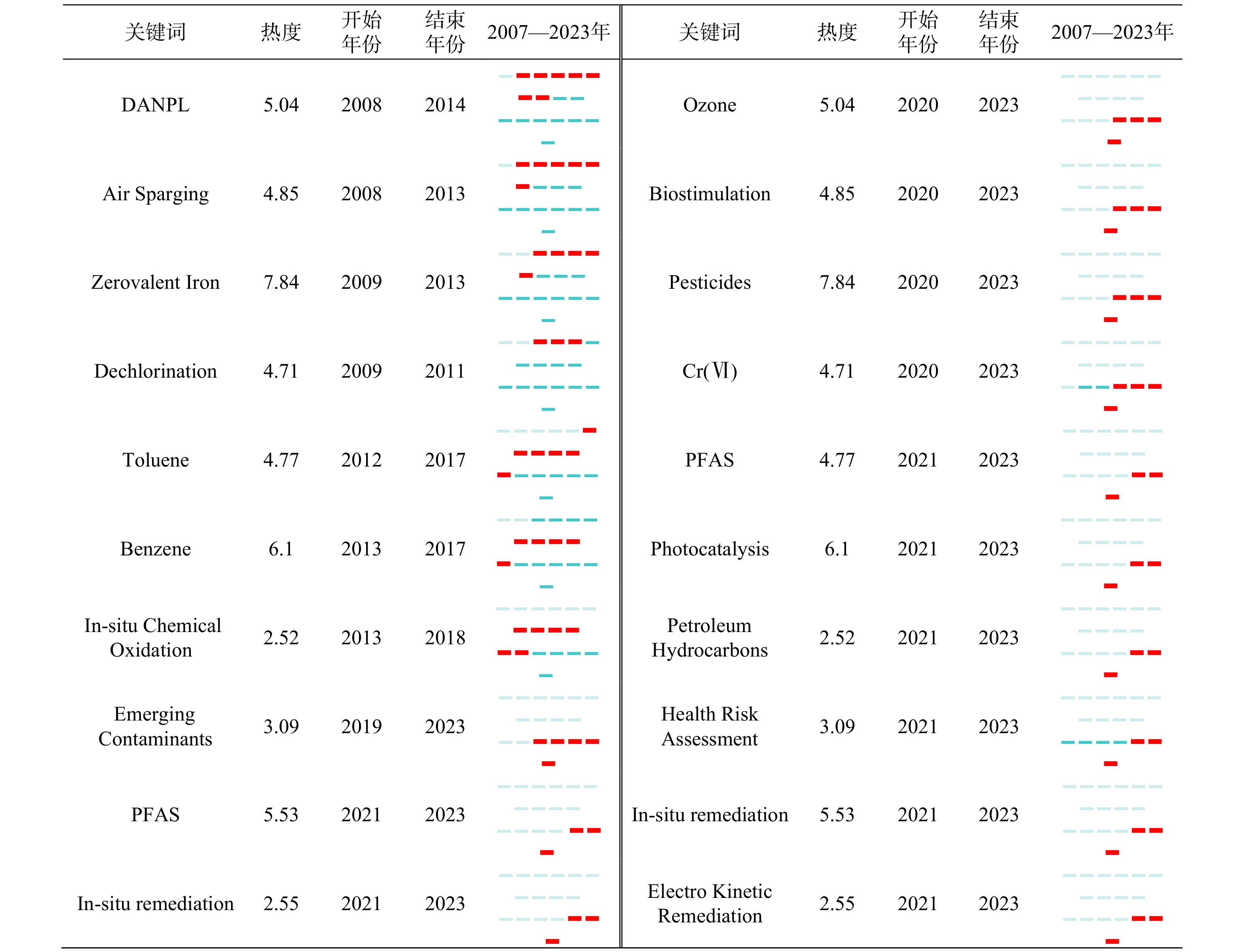
表 3 常用循环井系统主要装备及特点
Table 3. Main equipment and characteristics of commonly used circulating well systems
循环井系统 主要装备 技术要点 应用范围 NOVOCs系统 内井、外井组成井体(内外井管之间液压分离)、注气、抽气泵机及尾气处理装备 通过向含水层注入高压空气产生地下水循环流,并吹出挥发性污染物,通过真空抽提把污染物抽到地面进行处理。 可运用于粉质粘土到砂砾石等各种土壤类型 UVB系统 注气井被替换为提升泵 被提升的地下水通过脱附反应器去除水体中的挥发性污染物,而污染气体被抽提到地面进行处理,循环井上下滤水管用封隔器隔开,无直接的水力联系。 可应用于渗透性较差场地 DDC系统 井管和注气管 吹脱出的污染物引入包气带以进行微生物的降解,无地表气体处理系统。 对场地包气带的厚度、
渗透性以要求较高表 4 国内异位修复装备相关参数
Table 4. Parameters related to domestic ex situ repair equipment
修复装备 功率 /kW 处理能力 尺寸 /m 适用污染物 GY-BOX-P&T 4S 20 9.8 (t∙d−1) 12.12×2.48×2.9 有机污染 GY-BOX-P&T 2MS 35 40 (t∙d−1) 12.12×2.48×2.9 重金属、有机污染、悬浮颗粒 芬顿高级氧化一体化设备 35 15~20 (m3∙h−1) 9.3×2.4×2.8 有机污染 臭氧高级催化氧化集成修复设备 75 5~10 (m3∙h−1) 9.7×2.3×6.5 苯系物、酚类等有机物和氰化物污染 组合气浮一体化设备 15.8 25 (m3∙h−1) 7.2×2.0×2.6 石油烃污染 XJ-CT2 15 20 (t∙d−1) 6.5×2×2.5 挥发性有机物 XJ-HN10 8.56 20 (t∙d−1) 8×3×3 重金属污染 -
[1] TEW K, FETTER CW, BOVING T, et al. Contaminant Hydrogeology[J]. Environmental Earth Sciences, 2018, 77(22): 745. doi: 10.1007/s12665-018-7921-5 [2] CHEN Q, FAN G, NA W, et al. Past, present, and future of groundwater remediation research: A scientometric analysis[J]. International Journal of Environmental Research and Public Health, 2019, 16(20): 3975. doi: 10.3390/ijerph16203975 [3] AL-HASHIMI O A, HASHIM K, LOFFILL E, et al. A comprehensive review for groundwater contamination and remediation: Occurrence, migration and adsorption modelling[J]. Molecules, 2021, 26: 5913. doi: 10.3390/molecules26195913 [4] HASHIM M A, MUKHOPADHYAY S, SAHU J N, et al. Remediation technologies for heavy metal contaminated groundwater[J]. Journal of Environmental Management, 2011, 92(10): 2355-2388. doi: 10.1016/j.jenvman.2011.06.009 [5] CIAMPI P, ESPOSITO C, PETRANGELI PAPINI M. Review on groundwater circulation wells (GCWs) for aquifer remediation: State of the art, challenges, and future prospects[J]. Groundwater for Sustainable Development, 2024, 24: 101068. doi: 10.1016/j.gsd.2023.101068 [6] KALHOR K, GHASEMIZADEH R, RAJIC L, et al. Assessment of groundwater quality and remediation in karst aquifers: A review[J]. Groundwater for Sustainable Development, 2019, 8: 104-121. doi: 10.1016/j.gsd.2018.10.004 [7] CHEN C, SIE Y, LIN Y. A review of the multilevel slug test for characterizing aquifer heterogeneity[J]. Terrestrial, Atmospheric and Oceanic Sciences, 2012, 23: 131. doi: 10.3319/TAO.2011.10.03.01(Hy) [8] 费宇红, 刘雅慈, 李亚松, 等. 中国地下水污染修复方法和技术应用展望[J]. 中国地质, 2022, 49(2): 420-434. [9] TENNEY C M, LASTOSKIE C M, DYBAS M J. A reactor model for pulsed pumping groundwater remediation[J]. Water Research, 2004, 38(18): 3869-3880. doi: 10.1016/j.watres.2004.06.029 [10] KAHLER D M, KABALA Z. Rapidly pulsed pumping accelerates remediation in a vertical circulation well model[J]. Water, 2018, 10: 1423. doi: 10.3390/w10101423 [11] 王海鑫, 王水, 吕宗祥, 等. 一种滴灌式自动注入土壤地下水原位修复药剂注入工艺及装置: ZL202310047333.9[P]. 2023-05-02. [12] MUKHOPADHYAY A, DUTTAGUPTA S, MUKHERJEE A. Emerging organic contaminants in global community drinking water sources and supply: A review of occurrence, processes and remediation[J]. Journal of Environmental Chemical Engineering, 2022, 10(3): 107560. doi: 10.1016/j.jece.2022.107560 [13] MAJONE M, VERDINI R, AULENTA F, et al. In situ groundwater and sediment bioremediation: Barriers and perspectives at European contaminated sites[J]. New Biotechnology, 2015, 32(1): 133-146. doi: 10.1016/j.nbt.2014.02.011 [14] NEWELL C J, ADAMSON D T, KULKARNI P R, et al. Monitored natural attenuation to manage PFAS impacts to groundwater: Scientific basis[J]. Groundwater Monitoring & Remediation, 2021, 41(4): 76-89. [15] BRUSSEAU M L, GUO Z. Assessing contaminant-removal conditions and plume persistence through analysis of data from long-term pump-and-treat operations[J]. Journal of Contaminant Hydrology, 2014, 164: 16-24. doi: 10.1016/j.jconhyd.2014.05.004 [16] RIVETT M O, CHAPMAN S W, ALLEN-KING R M, et al. Pump-and-Treat remediation of chlorinated solvent contamination at a controlled Field-Experiment site[J]. Environmental Science & Technology, 2006, 40(21): 6770-6781. [17] GUO Z, BRUSSEAU M L, FOGG G E. Determining the long-term operational performance of pump and treat and the possibility of closure for a large TCE plume[J]. Journal of Hazardous Materials, 2019, 365: 796-803. doi: 10.1016/j.jhazmat.2018.11.057 [18] 蒲生彦. 地下水环境调查评估与污染防治分区理论及实践[M]. 北京: 科学出版社, 2023. [19] NASERI-RAD M, BERNDTSSON R, MCKNIGHT U S, et al. INSIDE-T: A groundwater contamination transport model for sustainability assessment in remediation practice[J]. Sustainability, 2021, 13(14): 7596. doi: 10.3390/su13147596 [20] PIERRO L, MATTURRO B, ROSSETTI S, et al. Polyhydroxyalkanoate as a slow-release carbon source for in situ bioremediation of contaminated aquifers: From laboratory investigation to pilot-scale testing in the field[J]. New Biotechnology, 2017, 37: 60-68. doi: 10.1016/j.nbt.2016.11.004 [21] TATTI F, PETRANGELI PAPINI M, TORRETTA V, et al. Experimental and numerical evaluation of Groundwater Circulation Wells as a remediation technology for persistent, low permeability contaminant source zones[J]. Journal of Contaminant Hydrology, 2019, 222: 89-100. doi: 10.1016/j.jconhyd.2019.03.001 [22] PAPINI M, MAJONE M, ARJMAND F, et al. First pilot test on the integration of GCW (Groundwater circulation well) with ENA (Enhanced natural attenuation) for chlorinated solvents source remediation[J]. Chemical Engineering Transactions, 2016, 49: 91-96. [23] ELMORE A C, DEANGELIS L. Modeling a ground water circulation well alternative[J]. Groundwater Monitoring & Remediation, 2004, 24(1): 66-73. [24] AKBARPOUR A, ZEYNALI M J, NAZERI TAHROUDI M. Locating optimal position of pumping wells in aquifer using Meta-Heuristic algorithms and finite element method[J]. Water Resources Management, 2020, 34(1): 21-34. doi: 10.1007/s11269-019-02386-6 [25] 任丽霞. 地下水修复多属性决策分析方法与应用研究[D]. 北京: 华北电力大学, 2017. [26] PARKER J, KIM U, KITANIDIS P, et al. Stochastic cost optimization of DNAPL remediation-Method description and sensitivity study[J]. Environmental Modelling & Software, 2012, 38: 74-88. [27] ZHAO B, SUN Z, LIU Y. An overview of in-situ remediation for nitrate in groundwater[J]. Science of the Total Environment, 2022, 804: 149981. doi: 10.1016/j.scitotenv.2021.149981 [28] YUAN L, WANG K, ZHAO Q, et al. An overview of in situ remediation for groundwater co-contaminated with heavy metals and petroleum hydrocarbons[J]. Journal of Environmental Management, 2024, 349: 119342. doi: 10.1016/j.jenvman.2023.119342 [29] SEOL Y, ZHANG H, SCHWARTZ F. A review of in situ chemical oxidation and heterogeneity[J]. Environmental & Engineering Geoscience, 2003, 9: 37-49. [30] GULERIA A, GUPTA P K, CHAKMA S, et al. Unraveling the fate and transport of DNAPLs in heterogeneous aquifer systems—A critical review and bibliometric analysis[J]. Sustainability, 2023, 15(10): 8214. doi: 10.3390/su15108214 [31] KHAN F I, HUSAIN T, HEJAZI R. An overview and analysis of site remediation technologies[J]. Journal of Environmental Management, 2004, 71(2): 95-122. [32] KUPPUSAMY S, PALANISAMI T, MALLAVARAPU M, et al. In-Situ remediation approaches for the management of contaminated sites: A comprehensive overview[J]. Reviews of environmental contamination and toxicology, 2016, 236: 1-115. [33] REDDY K R, KOSGI S, ZHOU J. A review of In-Situ air sparging for the remediation of VOC-Contaminated saturated soils and groundwater[J]. Hazardous Waste and Hazardous Materials, 1995, 12(2): 97-118. doi: 10.1089/hwm.1995.12.97 [34] 陈勉力, 雷国元, 周达, 等. 空气流体振荡提升曝气溶氧效率的效果及机制[J]. 化工环保, 2023, 43(3): 324-330. doi: 10.3969/j.issn.1006-1878.2023.03.007 [35] 王兵, 师雯, 孙玉波, 等. 陶瓷膜曝气强化臭氧传质研究[J]. 水处理技术, 2022, 48(3): 61-64+69. [36] 裘英华, 高梓浩, 王昊诚. 一种微纳米气泡制备装置及方法: ZL202210973287.0[P]. 2022-11-15. [37] XU W, LI W, WANG J, et al. Numerical simulation of gas–liquid Two-Phase flow CFD-PBM model in a micro–nanobubble generator[J]. Minerals, 2022, 12(10): 1270. doi: 10.3390/min12101270 [38] SHENG G, JOHNSTON C T, TEPPEN B J, et al. Potential contributions of smectite clays and organic matter to pesticide retention in soils[J]. Journal of Agricultural and Food Chemistry, 2001, 49(6): 2899-2907. doi: 10.1021/jf001485d [39] QIN C, ZHAO Y, ZHENG W, et al. Study on influencing factors on removal of chlorobenzene from unsaturated zone by soil vapor extraction[J]. Journal of Hazardous Materials, 2010, 176(1): 294-299. [40] XU L, ZHU L. Structures of OTMA-and DODMA-bentonite and their sorption characteristics towards organic compounds[J]. Journal of Colloid and Interface Science, 2009, 331(1): 8-14. doi: 10.1016/j.jcis.2008.11.030 [41] BALDWIN B R, NAKATSU C H, NEBE J, et al. Enumeration of aromatic oxygenase genes to evaluate biodegradation during multi-phase extraction at a gasoline-contaminated site[J]. Journal of Hazardous Materials, 2009, 163(2): 524-530. [42] 申家宁, 晏井春 , 高卫国, 等. 多相抽提技术在化工污染地块修复中的应用潜力[J]. 环境工程学报, 2021, 15(10): 3286-3296. [43] 陈窈君. 多相抽提-原位化学氧化协同修复技术研究[J]. 环境科学与技术, 2023, 46(02): 1-9. [44] 戴昕, 刘军, 赵慧慧, 等. 受LNAPL污染地下水的AS/MPE联用修复系统及方法: ZL202010926050.8 [P]. 2020-12-29. [45] CUI Y, ZHU Q, WEN Z. An improved sharp interface model for characterizing the transport and extraction of subsurface LNAPL[J]. Journal of Hydrology, 2023, 622: 129664. doi: 10.1016/j.jhydrol.2023.129664 [46] WEI K, MA J, XI B, et al. Recent progress on in-situ chemical oxidation for the remediation of petroleum contaminated soil and groundwater[J]. Journal of Hazardous Materials, 2022, 432: 128738. doi: 10.1016/j.jhazmat.2022.128738 [47] FAN S, XIN J, HUANG J, et al. Effectiveness of electron transfer and electron competition mechanism in Zero-Valent Iron-Based reductive groundwater remediation systems[J]. Progress in Chemistry, 2018, 30: 1035-1046. [48] RANC B, FAURE P, CROZE V, et al. Selection of oxidant doses for in situ chemical oxidation of soils contaminated by polycyclic aromatic hydrocarbons (PAHs): A review[J]. Journal of Hazardous Materials, 2016, 312: 280-297. doi: 10.1016/j.jhazmat.2016.03.068 [49] 严梓辰, 余海波, 唐伟, 等. 基于文献计量分析的场地化学氧化修复技术研究热点和趋势[J]. 环境工程学报, 2023, 17(10): 3423-3433. doi: 10.12030/j.cjee.202307100 [50] STROO H F, LEESON A, MARQUSEE J A, et al. Chlorinated ethene source remediation: Lessons learned[J]. Environmental Science & Technology, 2012, 46(12): 6438-6447. [51] ZHAO G, SHENG Y, WANG C, et al. In situ microbial remediation of crude oil-soaked marine sediments using zeolite carrier with a polymer coating[J]. Marine Pollution Bulletin, 2018, 129(1): 172-178. doi: 10.1016/j.marpolbul.2018.02.030 [52] KUYPERS M M M, MARCHANT H K, KARTAL B. The microbial nitrogen-cycling network[J]. Nature Reviews Microbiology, 2018, 16(5): 263-276. doi: 10.1038/nrmicro.2018.9 [53] ANNESER B, PILLONI G, BAYER A, et al. High resolution analysis of contaminated aquifer sediments and groundwater-what can be learned in terms of natural attenuation?[J]. Geomicrobiology Journal, 2010, 27: 130-142. doi: 10.1080/01490450903456723 [54] KHAN M A, SHARMA A, YADAV S, et al. Enhancing remediation of RDX-contaminated soil by introducing microbial formulation technology coupled with biostimulation[J]. Journal of Environmental Chemical Engineering, 2021, 9(5): 106019. doi: 10.1016/j.jece.2021.106019 [55] MICHALSEN M M, KING A S, ISTOK J D, et al. Spatially-distinct redox conditions and degradation rates following field-scale bioaugmentation for RDX-contaminated groundwater remediation[J]. Journal of Hazardous Materials, 2020, 387: 121529. doi: 10.1016/j.jhazmat.2019.121529 [56] HATZINGER P B, STREGER S H, BEGLEY J F. Enhancing aerobic biodegradation of 1, 2-dibromoethane in groundwater using ethane or propane and inorganic nutrients[J]. Journal of Contaminant Hydrology, 2015, 172: 61-70. doi: 10.1016/j.jconhyd.2014.11.006 [57] 邹莎莎. 零价铁/生物强化技术原位修复受氯代烯烃污染的地下水[J]. 净水技术, 2023, 42(S1): 227-233+269. [58] STAMM. Vertical circulation flows for vadose and groundwater zone in situ (bio-)remediation[J]. 1995. [59] ZHAO Y, QU D, ZHOU R, et al. Efficacy of forming biofilms by Pseudomonas migulae AN-1 toward in situ bioremediation of aniline-contaminated aquifer by groundwater circulation wells[J]. Environmental Science and Pollution Research, 2016, 23(12): 11568-11573. doi: 10.1007/s11356-016-6737-7 [60] YUAN S, LIU Y, ZHANG P, et al. Electrolytic groundwater circulation well for trichloroethylene degradation in a simulated aquifer[J]. Science China Technological Sciences, 2021, 64(2): 251-260. doi: 10.1007/s11431-019-1521-7 [61] 蒲生彦, 王宇, 王朋. 地下水循环井修复技术与应用: 关键问题、主要挑战及解决策略[J]. 安全与环境工程, 2021, 28(3): 78-86. [62] LI X, LI Z, CAILI D, et al. Bibliometric analysis of zerovalent iron particles research for environmental remediation from 2000 to 2019[J]. Environmental Science and Pollution Research, 2021, 28. [63] 张莉, 刘菲, 袁慧卿, 等. 地下水抽出处理技术研究进展与展望[J]. 现代地质, 2023, 37(04): 977-985. [64] U. S. Environmental Protection Agency. Remediation [EB/OL]. [2024-01-31].https://www.clu-in.org/techfocus/. pdf, 2021. [65] U. S. Environmental Protection Agency. Air sparging/ high vacuum extraction to remove chlorinated solvents in groundwater and soil [EB/OL]. [2024-01-31].https://www.clu-in.org/techfocus/default.focus/sec/Air%5FSparging/cat/Application/. pdf, 1998. [66] U. S. Environmental Protection Agency. Multi-phase extraction: state-of-the-practice [EB/OL]. [2024-01-31].https://www.clu-in.org/techfocus/default.focus/sec/Multi%2DPhase%5FExtraction/cat/Application/. pdf, 1999. [67] REECE J, CHRISTENSON M, KAMBHU A, et al. Remediating contaminated groundwater with an aerated, Direct-Push, oxidant delivery system[J]. Water, 2020, 12(12): 3383. doi: 10.3390/w12123383 [68] MILLER C, RUFFING S, KLINE R. Solar-powered in situ soil washing with surfactant to collect LNAPL[J]. Remediation Journal, 2012, 22(2): 69-79. doi: 10.1002/rem.21311 [69] IEG Technologie GmbH. Soil and groundwater remediation and aquifer restoration [EB/OL]. [2024-01-31].https://ieg-technology.com. pdf. [70] CIAMPI P, ESPOSITO C, BARTSCH E, et al. Remediation of chlorinated aliphatic hydrocarbons (CAHs) contaminated site coupling groundwater recirculation well (IEG-GCW®) with a peripheral injection of soluble nutrient supplement (IEG-C-MIX) via multilevel-injection wells (IEG-MIW)[J]. Heliyon, 2022, 8(11): e11402. doi: 10.1016/j.heliyon.2022.e11402 [71] EVAN COX. Electrokinetic-enhanced (EK-Enhanced) amendment delivery for remediation of low permeability and heterogeneous materials[R]. 2018. [72] State of California Department of General Services. Removal action completion report electrical resistance heating in source area former mercury cleaners site area[R]. 2018. [73] 谷庆宝. 中国土壤与地下水调查修复装备研究报告[R]. 2022. [74] 李佳璐, 侯盾, 崔双超, 等. 一种用于地下水原位、抽出处理的臭氧高级氧化系统: ZL202122044345.5[P]. 2021-11-23. [75] 程功弼, 赵宝正, 陈骉, 等. 一种纳米级原位多点注药一体式模块化智能设备: ZL201720504859.5[P]. 2017-08-29. [76] 程功弼, 沈秋悦, 徐金旺, 等. 一种强化土壤气相抽提和地下水修复的一体化修复系统: ZL201721880542.8[P]. 2022-10-25. [77] 侯德义. 我国工业场地地下水污染防治十大科技难题[J]. 环境科学研究, 2022, 35(09): 2015-2025. [78] GREEN C, LIAO L, NOLAN B, et al. Regional variability of nitrate fluxes in the unsaturated zone and groundwater, wisconsin, USA[J]. Water Resources Research, 2018, 54(1): 301-322. doi: 10.1002/2017WR022012 [79] YAO Y, MAO F, XIAO Y, et al. Modeling capillary fringe effect on petroleum vapor intrusion from groundwater contamination[J]. Water Research, 2019, 150: 111-119. doi: 10.1016/j.watres.2018.11.038 [80] A. V. P, SAJIKUMAR N. A review on the study of immiscible fluid flow in unsaturated porous media: Modelling and Remediation[J]. Journal of Porous Media, 2019, 22(8): 889-922. [81] HOU D, AL-TABBAA A, O CONNOR D, et al. Sustainable remediation and redevelopment of brownfield sites[J]. Nature Reviews Earth & Environment, 2023, 4(4): 271-286. [82] 中国环保产业协会, 中国环保产业发展状况报告[R]. 2022. -




 下载:
下载:
